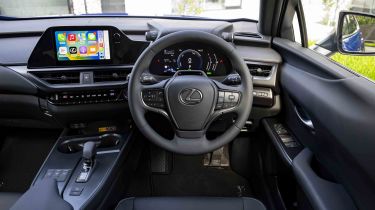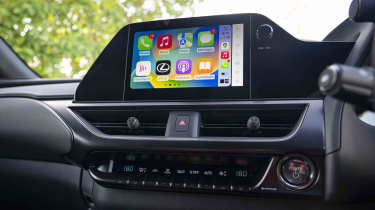Lexus UX - Interior, design and technology
The Lexus UX boasts a highly individual and quality-rich interior, and an upgraded infotainment system

One thing’s for certain with the Lexus UX: you won’t mistake it for any of its rivals. While the exterior design is filtered down from the larger Lexus SUVs, it’s refreshingly different in a segment filled with me-too designs.
The unmistakable Lexus ‘spindle’ grille features at the front, while LED headlights are standard across the range. The wheel arch mouldings are designed for the rigours of the urban jungle, rather than strenuous off-road challenges, while the rear lights span the entire vehicle's width.
The standard-fit 17-inch alloy wheels feature an aerodynamic design to reduce wind resistance and increase airflow, although non-aero 18-inch alloys are available on higher trim models. Ten paint colours are offered in the UK, including a couple developed exclusively for this country: Terrane Khaki and Celestial Blue. It looks particularly striking in solid red or metallic blue, but we wonder how many buyers will take this bold approach.
There’s a rich quality to the interior that helps the UX stand out in an overcrowded segment. Lexus has worked hard to give the car the feel of its larger saloons and SUVs, adding little touches to give the UX showroom appeal.
For example, the three-spoke steering wheel and analogue clock are lifted from the Lexus LS luxury saloon, while the engineers used brainwave analysis to produce the ‘perfect door-closing sound’. Lexus has even worked hard to reduce the noise and juddering of the electric windows.
Used - available now
This attention to detail, together with the use of quality materials and a unique approach to cabin design, means that the UX sets a high benchmark in the segment.
The seats are available in three finishes: fabric, leather or a combination of the two – there are also nine colours to choose from. As a note, not all hues and materials are available with each trim. For example, standard UX models are only available with black fabric seats, while F Sport models can come with striking Flare Red leather or more reserved black leather.
In a first for Lexus, the instrument panel can be finished in a trim inspired by the grain of Japanese ‘washi’ paper. According to Lexus, this creates a ‘calm and warm’ feeling.
Sat-nav, stereo and infotainment
Improvements have been made to the UX's infotainment tech by introducing two new screens that we've already seen in the Toyota C-HR. There's an 8.0-inch screen found in Urban, Premium, and F Sport Design trims, or the larger 12.3-inch display used from F Sport Design Tech and above.
We’ve tried the smaller of the two systems and found it to be a vast improvement over what went before. Its layout is simpler to understand and navigate, plus its response times are much faster.
All versions of UX come with wireless Apple CarPlay and Android Auto compatibility, but you’ll need to upgrade to the Premium Plus trim in order to get a wireless phone charging pad. Going for this trim also gets you a 10-speaker sound system over the standard 6-speaker set up. The two highest trims (Takumi and F Sport Takumi) gain an upgraded 13-speaker Mark Levison audio system.













